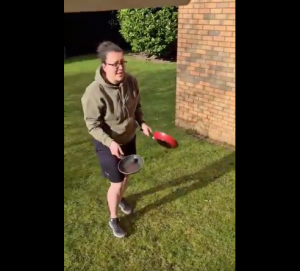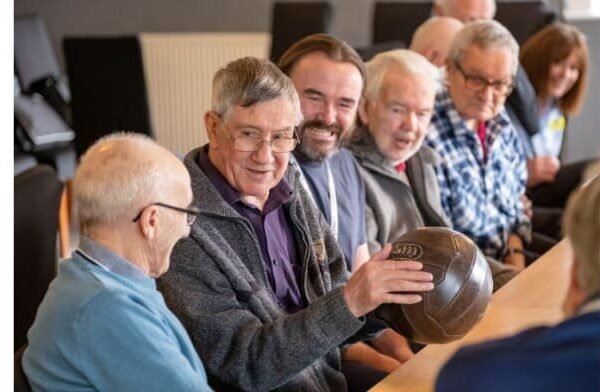Fears are growing across traditional clubs around what the future holds post-coronavirus, but the answer to sport’s recovery from this global pandemic may be staring us slap bang in the face as we play indoors, writes TOM ROWE.
The growth of social media and online technology has been seen by many in recent times as an existential threat to physical activity and sport participation. However, in the face of the current Covid-19 crisis, technology’s role and opportunities it provides in exercise are becoming increasingly apparent. With the closing of schools, gyms and sport facilities, adults and young people alike are turning to at-home fitness apps, online exercise classes and high-tech equipment.
These function not only as motivational tools to maintain physical fitness, but also provide important benefits for mental health and wellbeing, as well as maintaining community and connection during a time of social distancing. Rather than viewing this trend as a grim alternative born out of necessity, it is important to recognise the already growing popularity of online technology as a tool for fitness and appreciate its positive capabilities as we look towards a brighter future.
To reduce the transmission of the coronavirus, strict new curbs on life in the UK have left us spending a lot more time indoors. People are allowed to leave their home to do one form of isolated exercise a day, such as running, walking or cycling, but the closing of schools, gyms, and sports facilities have significantly limited accessibility to the ways of keeping physically active that were typically a part of many routines.
In the face of this new challenge, what has often been perceived to be the greatest threat to physical activity and sport participation may well prove to be its saviour. Online technology has provided many with a wide variety of alternative opportunities for keeping fit and active.
An article from Business Insider highlights the recent surge in popularity of at-home fitness apps. Lisa Eadicicco writes ‘in the past week alone, Daily Burn says it’s seen a 268% year-over-year increase in membership sign ups.’ Digital fitness services like Aaptiv has also seen a massive increase in customers, ‘especially in wellness programs that don’t require equipment, like those geared towards meditation, body weight exercises and improved sleep’. These fitness companies have recognised the opportunity, finding ways to make their service more accessible for newcomers: Aaptiv have curated some of their workout classes into a free podcast, Peloton is offering a free 90-day trial of its app, and MoreYoga has started offering free classes on its Youtube channel.

PE teacher Miss Butler from Newbattle High School has become an internet hit with her ‘sport for all’ approach, including the use of frying pans!
In the absence of PE lessons, schools and public services have employed innovative interventions that utilise online services in order to keep kids active from home. Fitness coach Joe Wicks has marketed himself as the ‘UK’s PE teacher’, live-streaming free classes from his Youtube channel every weekday from 9am. The classes designed for children and their parents are proving immensely popular. His first video, uploaded on Monday 23rd, reached 5 million views in 3 days.
PE teachers across Scotland have got in on the act with a wonderfully creative variety of ‘lessons’ for children from competitive challenges to fun skills, adapting your home and garden environment into creative playgrounds – even using frying pans, right and left, to hit balls against a wall. The challenge is activity, but the medium of teaching and coaching is new technology.
For those who can afford it, there are hi-tech options that can simulate sporting experiences and enhance fitness. BoxVR is a virtual reality video game that immerses users in high-intensity boxing-inspired workouts with customised goals and music playlists that change intensity levels. And at the top end of the scale golf simulators are proving popular, providing an indoor digital alternative to a traditional outdoor sport. There may be a fear that golfers are investing in these rather than their club memberships at present, and what that will mean further down the road.
Conversely, how might this technology contribute to a growth in golfers? The tech capabilities of simulators have seen much improvement over the last few years, with sensory technology now capable of capturing swing, impact and spin in the way that only golf professionals and coaches could before. So, now amateurs with high handicaps can improve their ‘swing planes’ without leaving the house (or garage) and how much might that fuel a rise in golf attraction following this ‘off-period’.

Golf simulators are becoming popular during isolation – will they help or hinder golf club memberships?
The sudden surge in popularity of at-home fitness apps and online fitness videos is down to the coronavirus, but it was already building a head of steam. The convenience, personal customisability and entertainment value – the crucial, attractive element of fun – suggests that enforced ‘isolation’ may only serve to accelerate that with new habits being formed that could stick when we return to normal life.
So, what does that mean for traditional sport and outdoor activity? That probably depends on the sport and attitudes of the people within it. If embraced, there is potential for this period to function as an awakening for sports clubs and facilities to the value of integrating online technology. The fast-developing games are naturally designed commercially to appeal to everyone, with increasing diversity and wide-ranging functions, and they are doing a decent job of reaching those typically averse to traditional organised sport.
So, the question is probably ‘can traditional sports adapt to exploit this growth?’ Understandably, many will have enough to worry about this week and next in trying to fathom how they replace lost income, members and staff, but there is a strong argument to be made that this crisis has accelerated the need for all sports to adapt. Online technology is coming to the fore at a time of global concern and should be viewed as a supplementary tool to sport participation and fitness, rather than as an invading replacement.







Thought Piece from Charlie Raeburn for Reform Scotland